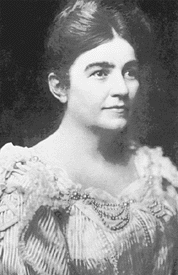Seeking a form of self - expression
Through her marriage to Charles Dorwin Porter in 1886, Mrs. Porter gained a measure of financial security and independence. She expressed pride in her role as a wife and mother, but she wanted to do more. Even the beautiful Limberlost Cabin built for her by her husband in Geneva did not help. She expressed her strong feelings in Homing with the Birds:
In those days I was experiencing constant struggle to find an outlet for the tumult in my being. . . . During my early days in that Cabin I went through more agony than should fall to the lot of the average seeker after a form of self-expression.

Gene Stratton-Porter
Department of Natural Resources.
In her 1928 book, Lady of the Limberlost, Jeannette Porter Meehan wrote of her mother during that time:
. . . the fever to write had raged within Mother until it became a compelling influence and dominated her whole life, her home, her entertainments, her amusements, and her work. After I was old enough to go to school, Mother spent many secret hours with her pen.
Mrs. Porter wrote about what she knew best--nature.
Self-expression was not the only reason Mrs. Porter began to write for publication. In 1895, Charles Porter had committed his remaining assets to his new bank. Mrs. Porter knew that financial freedom was as important as her creative self-expression. She later wrote about the tension between a career and family:
Then I took a bold step, the first in my self-emancipation. Money was beginning to come in, and I had some in my purse of my very own that I had earned when no one knew I was working. I argued that if I kept my family so comfortable that they missed nothing from my usual routine, I had a right to do what I could toward furthering my personal ambitions . . . until I could earn money enough to hire capable people to take my place (Meehan, 124).
This first bold step was obtaining her own post office box in case her work was not accepted and returned by publishers.
Her successful nature writing had gone undetected through careful planning:
My husband's drug store carried books and magazines . . . few people in our locality read Recreation and Outing. None of them were interested in photography, and very few in Natural Science, so that what I was doing was not known (Meehan, 124).
Her first short story was published in 1901 in Metropolitan magazine. She was immediately discovered by an alert--and complimentary--clerk in her husband's store. Soon Mrs. Porter was confidently writing both fiction and nature materials regularly and with great popular success.
